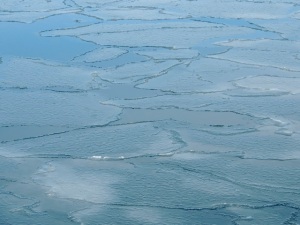We have been surrounded by pancakes for the past few days now – but of the ice variety rather than the culinary! Pancake ice is just one stage of many in the route that sea ice takes to form the more solid looking, snow topped ice floes that we’re more used to associating with sea ice. The weather has been so cold here recently that we’ve been able to see nearly all of the first stages of sea ice formation, as well as lots of older sea ice from last winter!
Pancakes of ice!
The freezing point of seawater is cooler than that of freshwater – due to its salt content – at approximately -1.9C. As the seawater cools to the freezing point, ice crystals begin to form, and when a significant amount of these are present they are known as frazil ice. This type of initial sea ice is very difficult to see, as it hasn’t yet formed a larger scale structure.
As more and more groups of frazil ice join together, they form the next stage of sea ice formation; grease ice. This is so named due to the appearance it gives the sea surface when it forms – it looks like streaks of grease across the surface! This layer is only a couple of centimetres thick, and as it thickens it will become nilas ice, which can be up to 10 cm thick. This is still quite a delicate layer of ice, and can be easily broken through by the ship.
Since nilas ice is still quite thin, it can be affected by wind and waves. As these processes affect the ice, the separate nilas ‘floes’ will begin to collide with each other, rumpling the outer edges on impact. This results in the type of ice that we have seen the most recently; pancake ice! It is very distinctive through its flat inner area, with a raised rim – a bit like a pancake or a deep pan pizza.
Over time, the thickness of these pancake ice floes will increase, and they’ll begin to join together to form this year’s sea ice. The sea ice is still considered ‘new ice’ until it’s about 30 cm thick, and only becomes ‘first year ice’ when it is between 30 – 120 cm. Any ice that survives next summer to continue to grow during the next winter becomes ‘old ice’ – eventually becoming ‘multiyear ice’ once it has weathered several summers.
A lead in thick sea ice
For sea ice to form, salt cannot be present and so large amounts of salt are removed from the seawater whilst it is freezing. The seawater contains on average 3.4% salt, yet first year sea ice will only have 0.6% salt (all this salt gets forced into the surrounding seawater with important consequences for ocean circulation). By the time the sea ice becomes multiyear ice it will only have 0.1-0.2% salt content and will begin to take on a blueish hue – this is a much more solid type of ice and wouldn’t be ideal for the ship to break through!
Luckily, we’ve been able to get everywhere that we’ve needed to go to so far; the thickest ice we’ve had to break through was thick first year sea ice (formed over the winter). Hopefully this good fortune will continue for our final few CTD stations and last mooring on the eastern shelf edge of the Amundsen Sea!
Via: Ocean2ice blog

